
Hot to extremely hot daytime temperatures remain in place across coastal southern California and the interior Northwest, with the Northwest carrying the potential for record-breaking high temperatures. A combination of monsoonal moisture and tropical moisture ahead of tropical cyclone Lorena will bring a marginal to slight risk of excessive rainfall across the southwest U.S. this week. Read More >
Overview

The National Weather Service wants everyone to be part of a Weather-Ready Nation. Summer thunderstorms form every day and with those storms come a dangerous threat: lightning. Lightning is unpredictable, occurring at any time and striking up to 10-15 miles away from the storm. Are you weather-ready? Now is the time to make sure you know how to stay safe when severe weather threatens. Therefore, the week of June 18th to 24th has been designated National Lightning Safety Awareness Week.
This page has been created to raise lightning awareness for the High Plains. Storms can pop up almost any day during the summer, so stay aware and please prepare!
Anytime the threat for severe weather exists, stay updated on the latest weather information by going to the National Weather Service Website, https://www.weather.gov or mobile.weather.gov, by tuning in to NOAA Weather Radio, or your local television and radio stations.
Additional safety information can be found at: www.weather.gov/safety
Sunday:
Lightning strikes the ground millions of times each year and with many of us participating in outdoor activities, we need to learn how to protect ourselves from lightning hazards. Lightning is also responsible for about half of the wildfires in Colorado each year. When lightning or other conditions are conducive to a high wildfire threat, the National Weather Service will issue Fire Weather Watches or Red Flag Warnings.
During this week a series of statements will cover a variety of topics related to lightning and wildfires.
Sunday..........Introduction
Monday..........The science of lightning
Tuesday.........Outdoor lightning risk reduction
Wednesday....Indoor lightning safety
Thursday........Lightning safety and outdoor activities
Friday.............Lightning survivors
Saturday.........Conclusion
NOAA’s lightning website which contains abundant information on lightning safety can be found at:
https://www.weather.gov/safety/lightning
Sunday's Social Media Posts
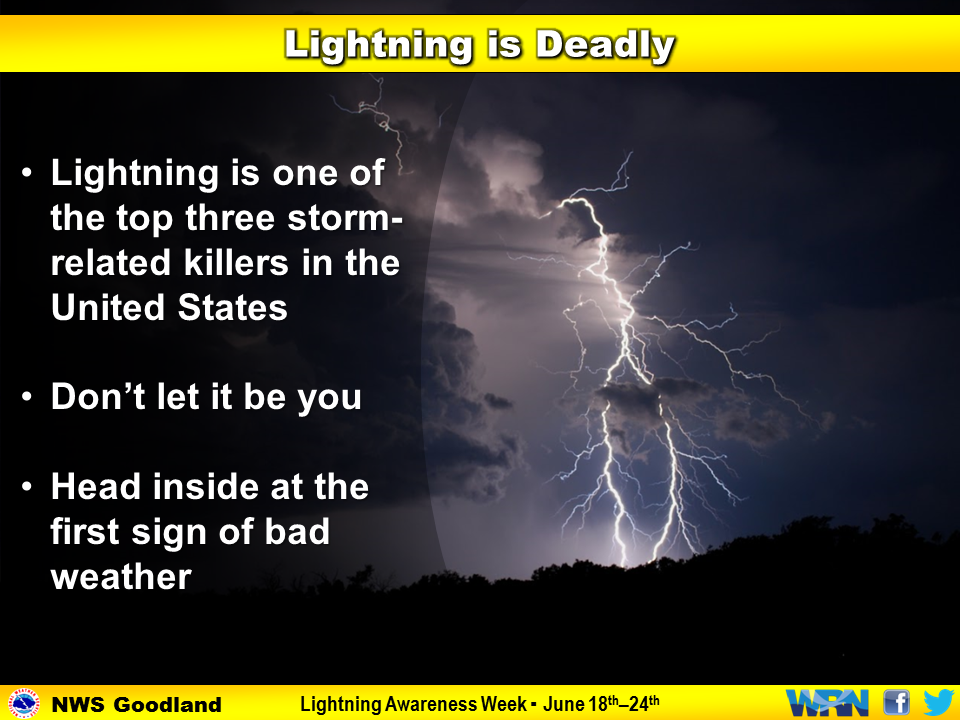 |
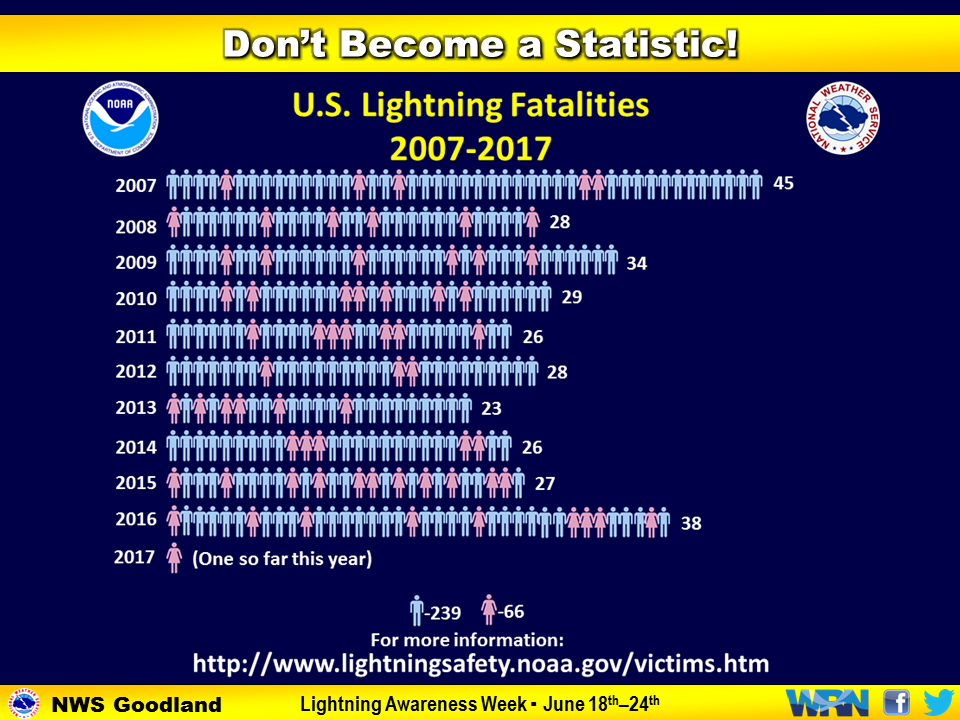 |
Monday:
Every thunderstorm produces lightning. Lightning is simply a giant spark that moves within the cloud, between the clouds, or between the cloud and the ground. As lightning passes through the air, it heats the air rapidly to a temperature of about fifty thousand degrees Fahrenheit. This causes a rapid expansion of the air along the lightning channel. This rapid expansion causes a shock wave that we hear as thunder.
Thunderstorms grow tens of thousands of feet into the atmosphere. Within the thunderstorm, precipitation forms as ice crystals, graupel, and rain. Collisions between these particles causes electrical charges to separate. With time, the top of the thunderstorm becomes positively charged and the lower part of the thunderstorm becomes negatively charged.
Due to the pool of negative charges in the lower part of the storm, a pool of positive charges will develop along the ground and follow the cloud base like a shadow. Farther away from the cloud base, but under the positively charged anvil, a strong negative charge may be induced along the ground.
Cloud-to-ground lightning can either be a negatively charged flash or a positively charged flash. The negative flash usually occurs between the negative charges in the lower part of the storm and the positive charges on the ground under and near the cloud base. Positive flashes usually occur between the positively charged upper levels of the storm and the negatively charged area surrounding the storm.
In the negative cloud-to-ground flash, a negatively-charged step leader forms and begins to move down toward the ground. As this step leader approaches the ground, streamers of positive charge move upward from the Earth's surface. When these upward streamers meet the step leader, the connection is completed and the result is a cloud-to-ground lightning flash. The entire process takes place in fractions of a second. If you are near, or under a thunderstorm, and your hair rises, you are in an area where the positive electrical charges are rising up objects towards the storm. You are in a very dangerous location, because lightning may be about to strike!
The process for a positive flash is similar except that a positive channel usually originates in the anvil of the storm and surges downward. In this case, streamers of negative charge shoot up to meet the positively charged channel as it approaches the ground. When a connection is made, a positive flash of lightning occurs.
While both negative and positive flashes of lightning can be deadly, the positive flashes generally are more destructive as they typically deliver more overall electrical charge to the ground, and they remain in contact with the ground surface for a relatively longer period of time as compared to a negative cloud-to-ground flash.
Monday's Social Media Posts
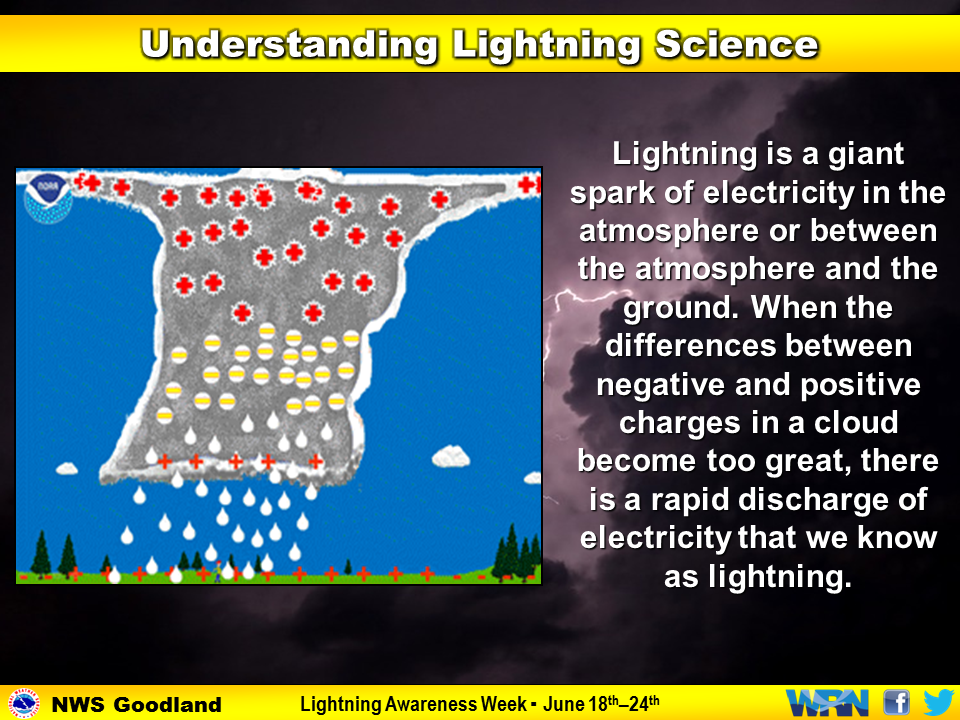 |
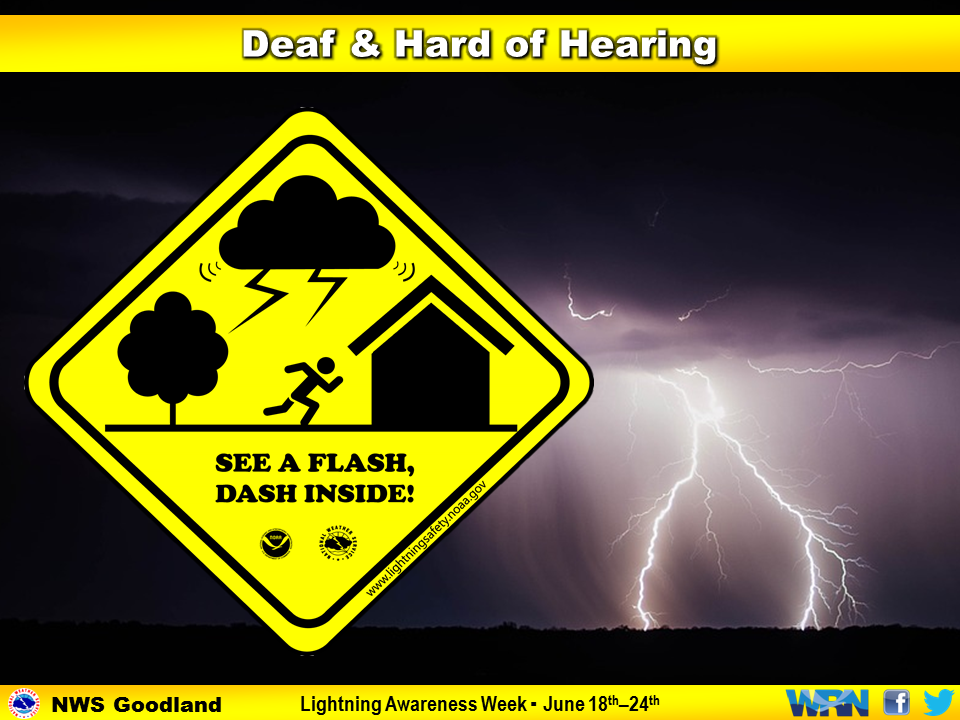 |
Tuesday:
Outdoors is the most dangerous place to be during a thunderstorm. Each year, nearly all people in the United States who are injured or killed by lightning were involved in an outdoor activity. They were struck while working outside, were at or participating at an outdoor sporting event, or were boating or fishing. Other examples include people struck while they were hiking, mowing the lawn or simply going to or from their car. Quite a few were on their own property when they were struck.
Unfortunately, there is no place outside that is safe from lightning. The only safe place to be when lightning is occurring is either inside a substantial building, or an enclosed automobile.
An informed decision will help you avoid being in an area where lightning is expected to occur. Before heading out, get an updated forecast. Stay tuned to NOAA Weather Radio, check National Weather Service web sites, go to your favorite broadcast or print media, or access your favorite weather apps on your cell phone for the latest forecast. If thunderstorms are in the forecast, consider planning an alternate indoor activity or, if you still plan to be outside, make a plan which will allow you to quickly get to a safe shelter if a storm should develop.
Once you are outside, keep up-to-date on the weather via your smart phone or portable NOAA weather radio receiver. Check for updated forecasts. Check if storms are near you by checking the latest radar imagery on your cell phone. There are now several smart phone apps you can purchase that show you real-time lightning activity in your area. Do not forget to simply look around you to make sure storms are not developing in your vicinity.
If you are outside, such as a park, a lake, or an outdoor sporting event, know where the nearest safe location can be accessed. A safe location is any substantial building (a substantial building is a structure which is fully enclosed and has electrical wiring and plumbing). In addition, any enclosed hard-topped car or truck also offers excellent protection from a lightning strike. Once you hear thunder or see lightning, immediately stop what you are doing and quickly get to the safe shelter.
What can you do to reduce your chances of being injured or killed by lighting if no safe shelter is nearby? This situation typically occurs to people who are hiking or camping in the backcountry. Unfortunately, in this scenario, there is not much you can do to reduce your risk from being struck by lightning. The best thing to do is move away from tall isolated objects, such as trees. Stay away from wide open areas. Stay as low as possible with your feet close together if lightning is nearby. If you are with a group of people, spread out, that way if someone is struck by lightning, the others can offer first aid.
Tuesday's Social Media Posts
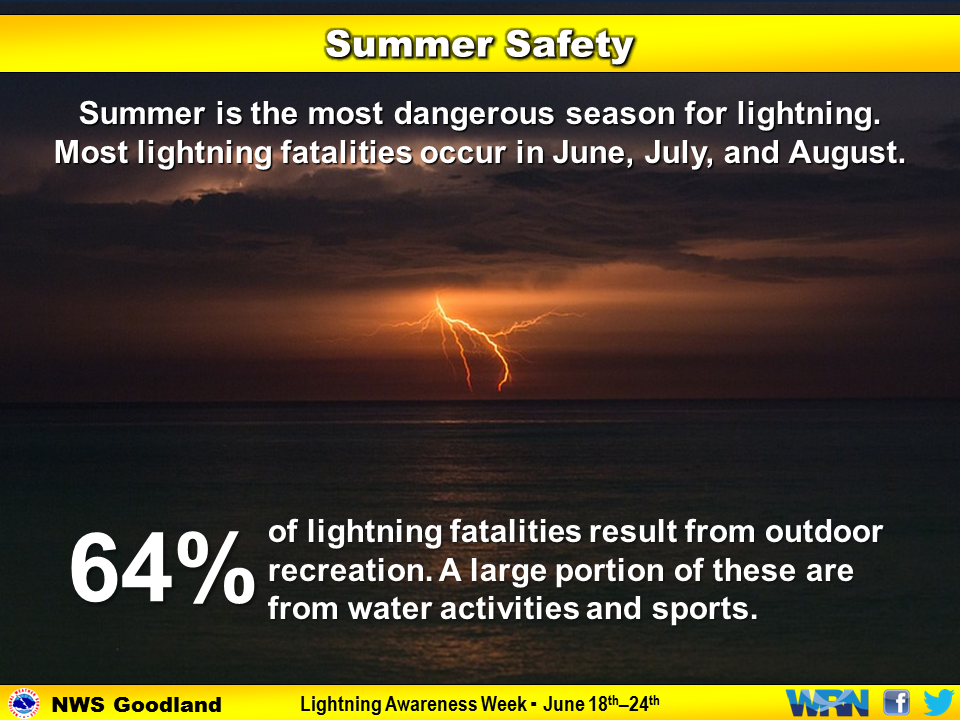 |
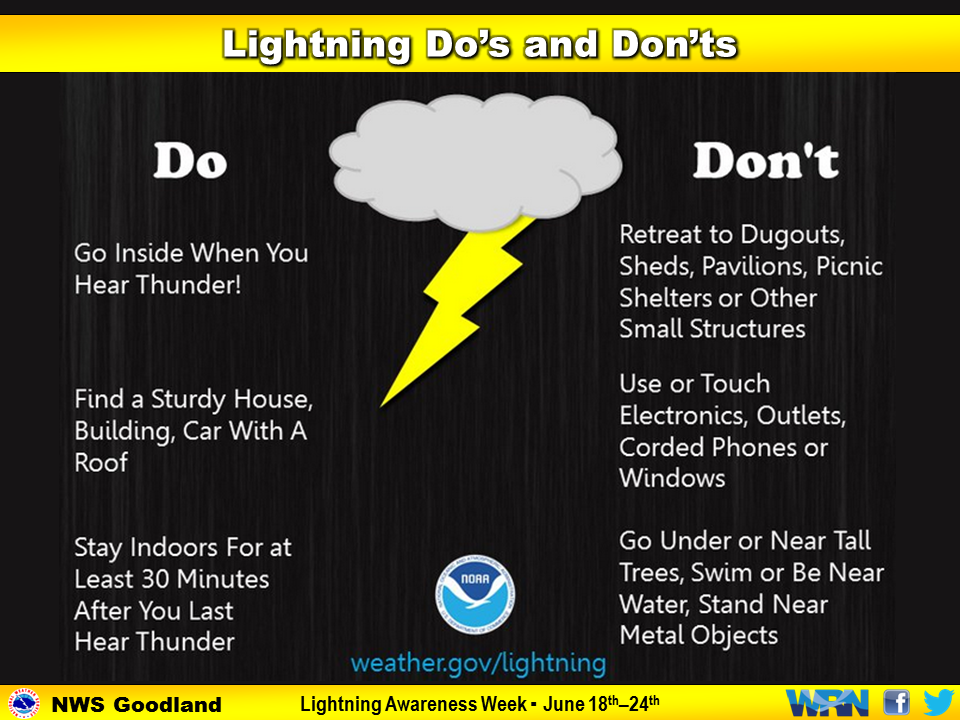 |
Wednesday:
Statistics tell us that we are much less likely to become a lightning strike victim if we are inside a substantial structure such as a home or office building. While nearly all people who are injured or killed by lightning were outdoors, a small percentage of people are injured by lightning while indoors. Therefore, it is important to discuss lightning safety while indoors.
The dangerous electrical current associated with a lightning strike typically enters a structure through wires, cables or pipes that connect to the building from the outside. Lightning can also directly enter into a structure through an open window, door or garage door. Once in a structure, the dangerous current can travel through the electrical, phone, cable and plumbing systems and through metal wires or bars in concrete walls or flooring.
Corded electronic devices are the leading cause of indoor lightning injuries in the United States. These include personal computer keyboards, game consoles, and corded phones. Other injuries have occurred when people were close by to televisions which connect to an outside cable or satellite system. Open windows, doors and garage doors allow for a direct strike to enter a home, so make sure all windows and doors are closed when lightning is occurring. Never watch a lightning storm from a porch or open garage door.
It is very important to stay away from any plumbing when lightning is occurring outside. This includes sinks, bathtubs and showers. When lightning is occurring, do not hand wash dishes, do not give kids a bath, and do not take a shower. It is best to wait to do laundry until after the storm goes by as washers and dryers are connected to both the electrical and plumbing systems.
People have also been injured while leaning and standing near concrete in their homes and offices. This is due to metal rebar which is in the concrete, and this metal acts as a conductor when lightning hits the building.
Here is a summary of lightning safety tips for inside the home:
1. Avoid corded electronics and electrical equipment.
2. Avoid contact with plumbing, such as taking a shower, bathing, hand washing dishes or doing laundry.
3. Stay away from windows, doors, garages and porches.
4. Do not lie on concrete floors or lean against concrete walls.
5. If a substantial building is not nearby, an enclosed car or truck offers excellent protection from lightning.
Here are a couple of web sites that contain additional lightning information:
Wednesday's Social Media Posts
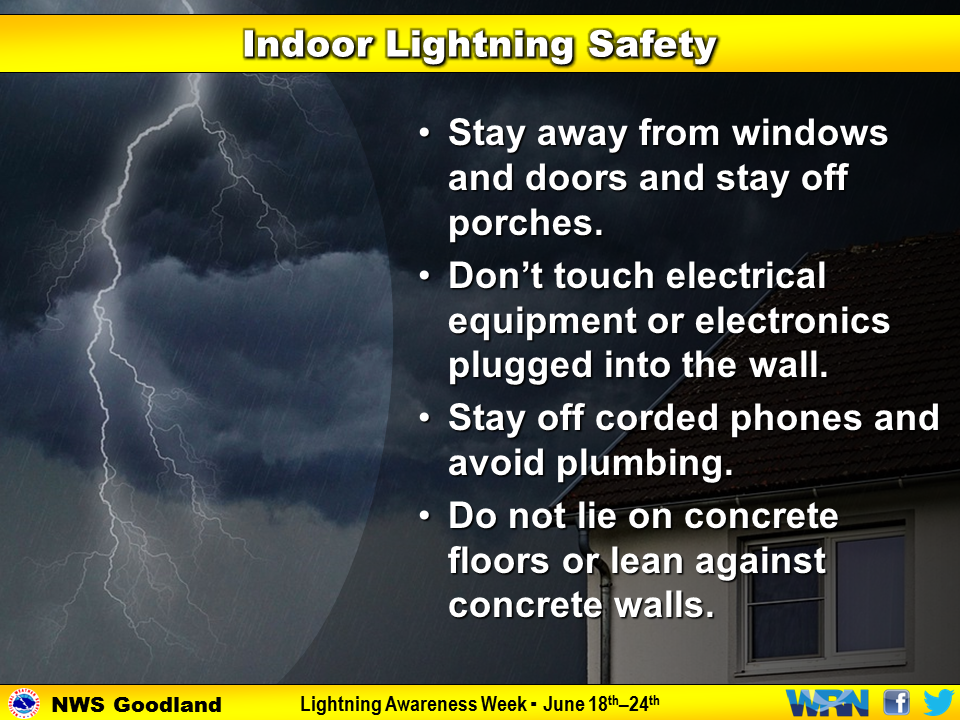 |
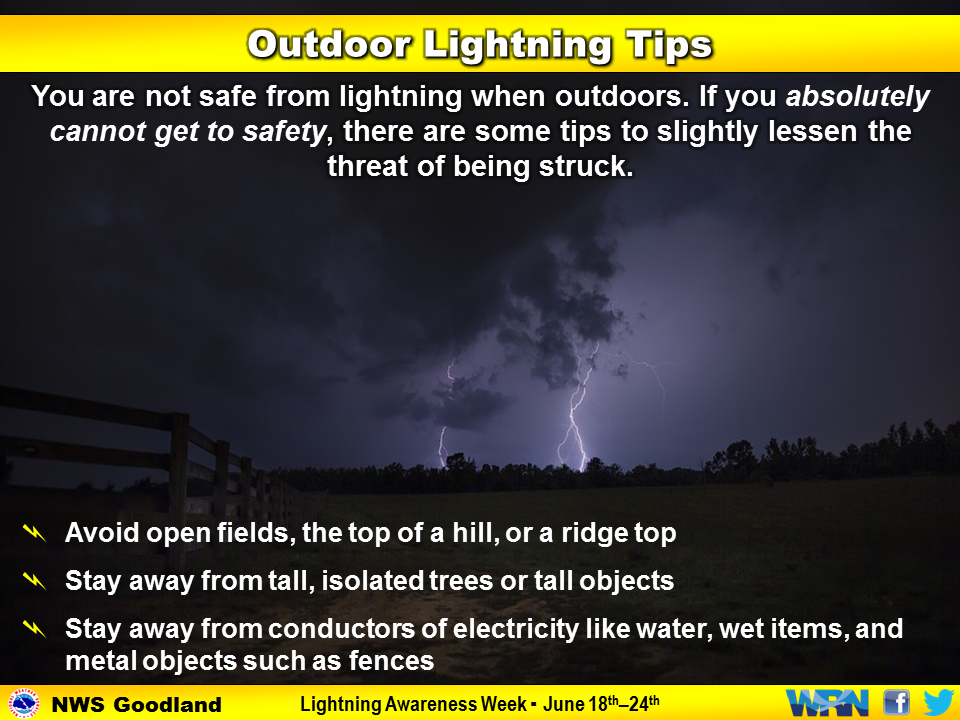 |
Thursday:
It's a common situation — a thunderstorm is approaching or nearby. Are conditions outside safe, or is it time to head for safe place? Not wanting to appear overly cautious, many people wait far too long before reacting to this potentially deadly weather threat.
Anyone who is outside in the summer needs to understand some basic information about lightning. Each year, thunderstorms produce an estimated 20 to 25 million cloud-to-ground lightning flashes in the United States — each one of those flashes is a potential killer. Some of those flashes strike directly under the storm where it is raining, but some of the flashes reach out away from the storm where people perceive the lightning threat to be low or nonexistent, and catch people by surprise.
Based on cases documented by the National Weather Service in recent years, about 30 people are killed by lightning each year and hundreds more are injured, some suffering devastating neurological injuries that persist for the rest of their lives. About two thirds of the deaths are associated with outdoor recreational activities.
Officials responsible for sports outdoor activities need to understand thunderstorms and lightning to make educated decisions on when to seek safety. Without this knowledge, officials may base their decisions on personal experience and or a desire to complete the activity. Unfortunately, decisions based on past experience or a desire to complete the activity can put the lives of those involved at risk.
For organized outdoor activities, the National Weather Service recommends that organizers have a lightning safety plan and follow it without exception. The plan should give clear and specific safety guidelines to eliminate errors in judgment. These guidelines should address the following questions.
Thursday's Social Media Posts
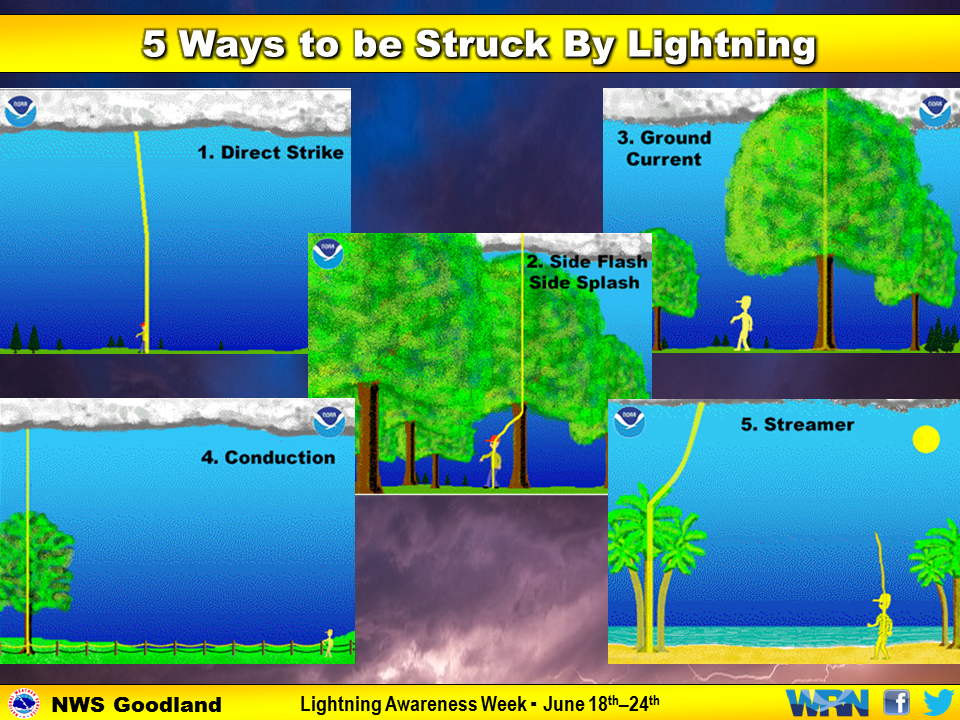 |
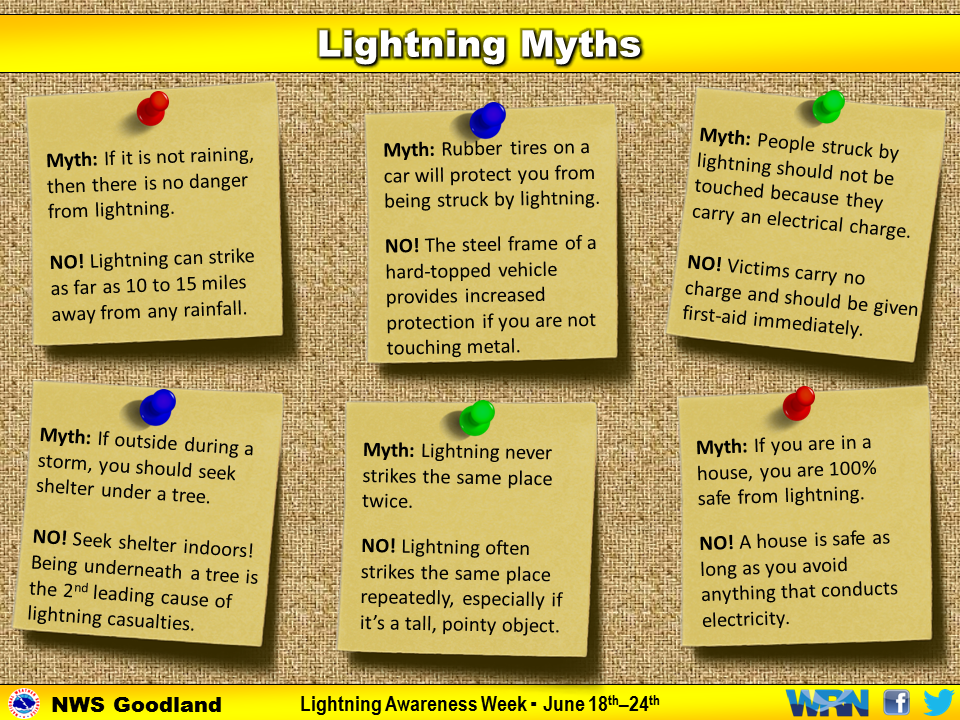 |
Friday:
The facts about lightning strike victims:
While any lightning fatality is tragic, injuries caused by lightning can be devastating to both the victim and the family. For those who have a family member or relative that suffers a significant disability from lightning, life changes forever. In addition to the physical pain and mental anguish suffered by the victim and their family, the incident may lead to a loss of income for all involved as medical expenses can drain the family’s financial resources.
If someone is struck by lightning, it is critically important that they receive the appropriate medical attention immediately. Some deaths can be prevented if the victims are attended to promptly. Lightning victims do not carry an electrical charge and are safe to handle. First, check to see that the victim is breathing and has a pulse, and start cardio-pulmonary resuscitation, if needed. Then have someone dial 911. If possible, move the victim to a safer place. Do not let the rescuers become lightning victims. Lightning can strike the same place twice.
Lightning strike victims may face many mental challenges that they will have to live with for the rest of their lives. When the brain is affected by a lightning strike, the person often has difficulty with many of the mental processes that most people take for granted. The person may suffer from short-term memory loss, and may have difficulty remembering new information and accessing old information. Victims may often find it very difficult to carry on more than one task at a time, and may be easily distracted. Their personality may change and they may become easily irritated.
Lightning strike victims often become easily fatigued and may become exhausted after only a few hours of work. This may be because mental tasks that were once automatic may now require intense concentration to accomplish. Although some victims may sleep excessively at first, after a few weeks many find it difficult to sleep more than two or three hours at a time.
Another common long-term problem for survivors is pain.
Medically, pain is difficult to quantify. Lightning strike victims often suffer irreparable nerve damage that causes intense pain that affects the ability to function. Many survivors complain of chronic headaches, some of which are very intense and debilitating.
Lightning Strike and Electric Shock Survivors International is a support group for individuals and families that are struggling with life after a lightning injury. Helpful information is available at their web address: www.lightning-strike.org
Friday's Social Media Posts
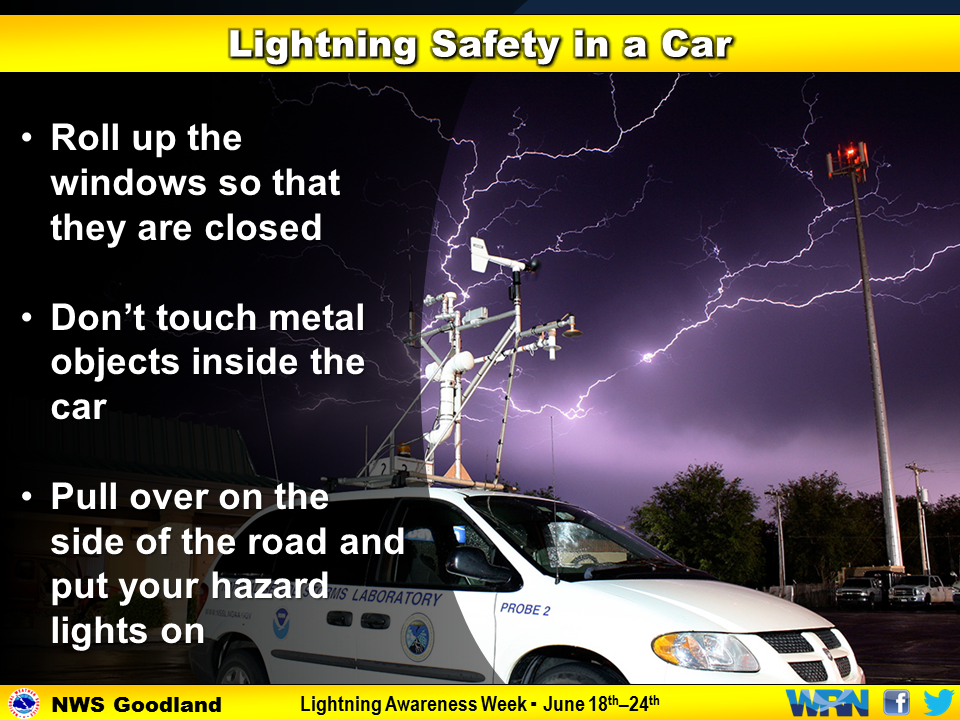 |
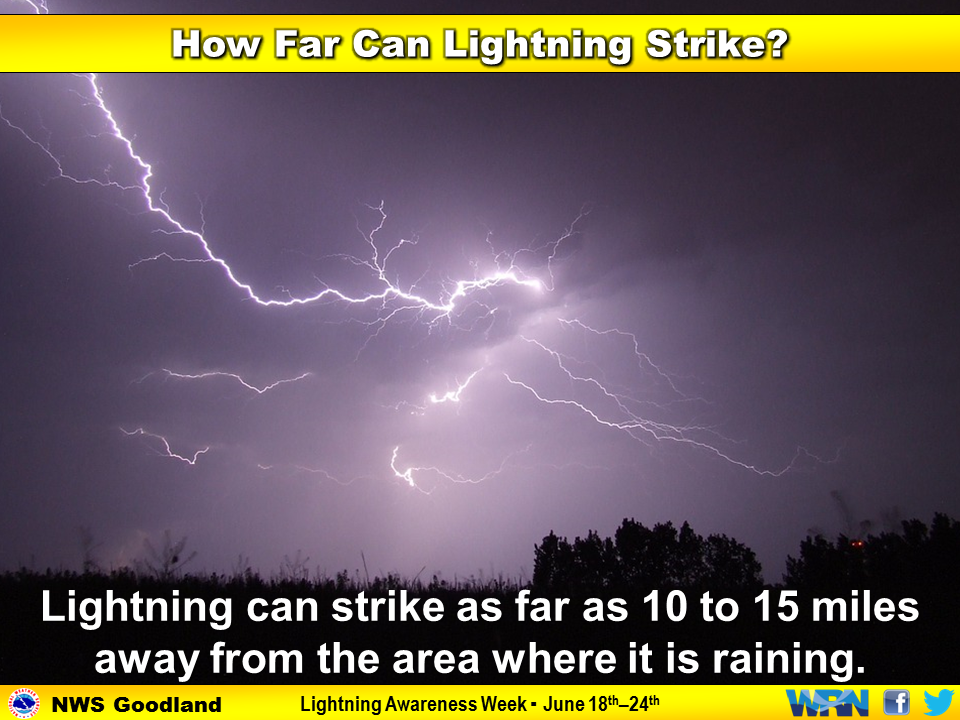 |
Saturday:
The best way for you to protect yourself from lightning is to avoid the threat. You simply don’t want to be caught outside in a storm. Have a lightning safety plan, and cancel or postpone activities early if thunderstorms are expected. Monitor weather conditions and get to a safe place before the weather becomes threatening. Substantial buildings and hard-topped vehicles are safe options. Rain shelters, small sheds, and open vehicles are not safe.
When inside, do not touch anything that is plugged into an electrical outlet, plumbing, and corded phones. Cell phones and cordless phones are safe. Also, keep away from outside doors and windows and do not lie on a garage floor.
Finally, wait 30 minutes after the last lightning or thunder before going back outside. If everyone followed those simple rules, the number of lightning casualties in this country could be greatly reduced.
If someone is struck by lightning, they may need immediate medical attention. Lightning victims do not carry an electrical charge and are safe to touch. Call 911 and monitor the victim. Start CPR or use an Automated External Defibrillator if needed.
Saturday's Social Media Posts
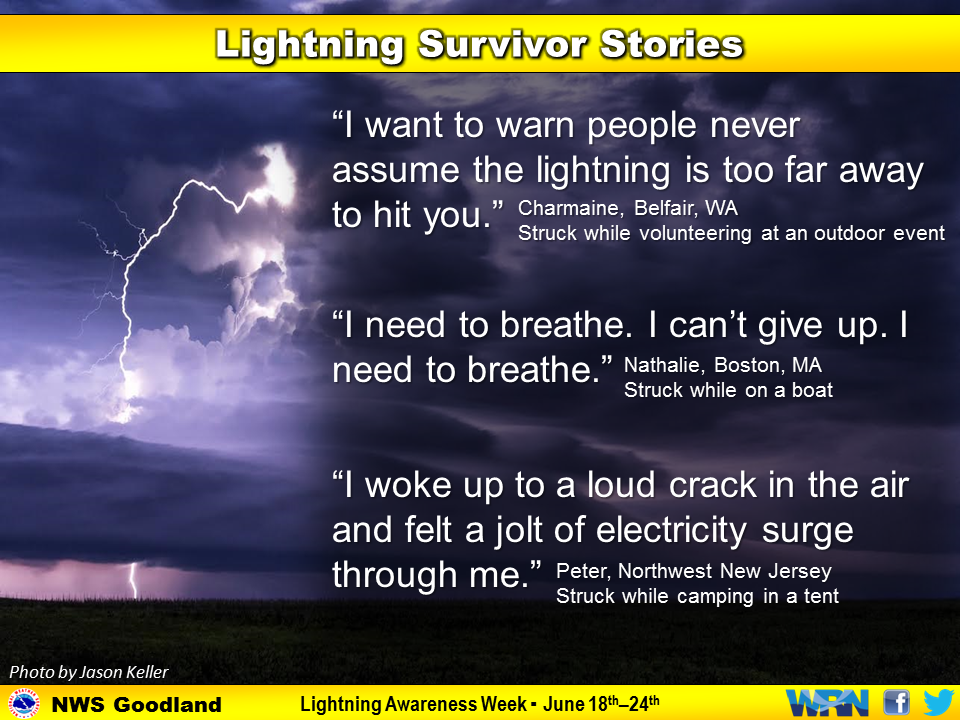 |
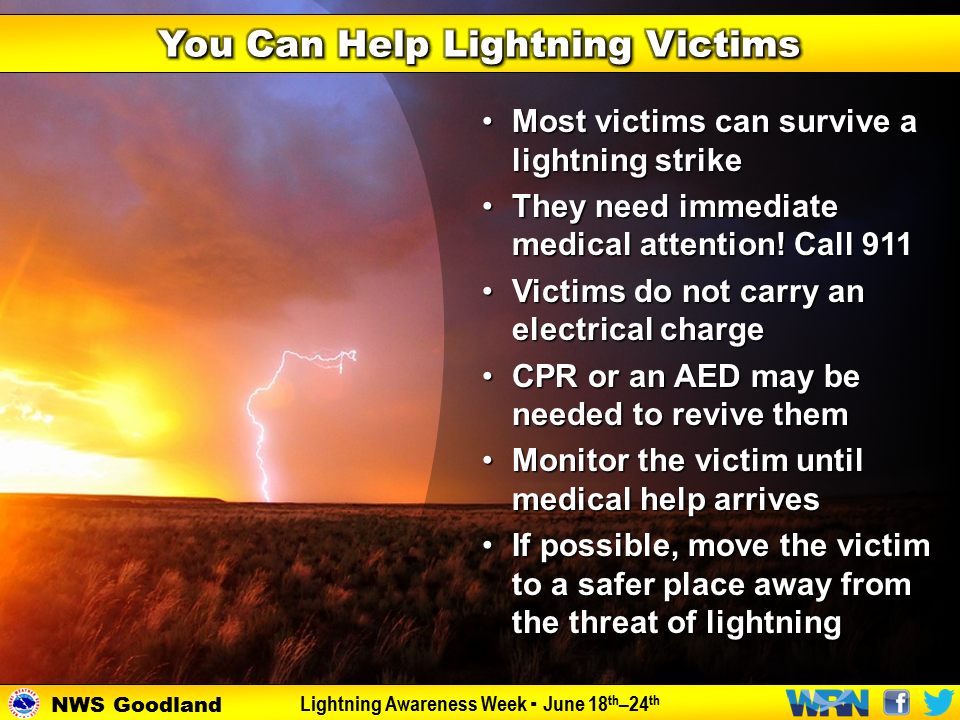 |
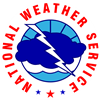 |
Media use of NWS Web News Stories is encouraged! Please acknowledge the NWS as the source of any news information accessed from this site. |
 |